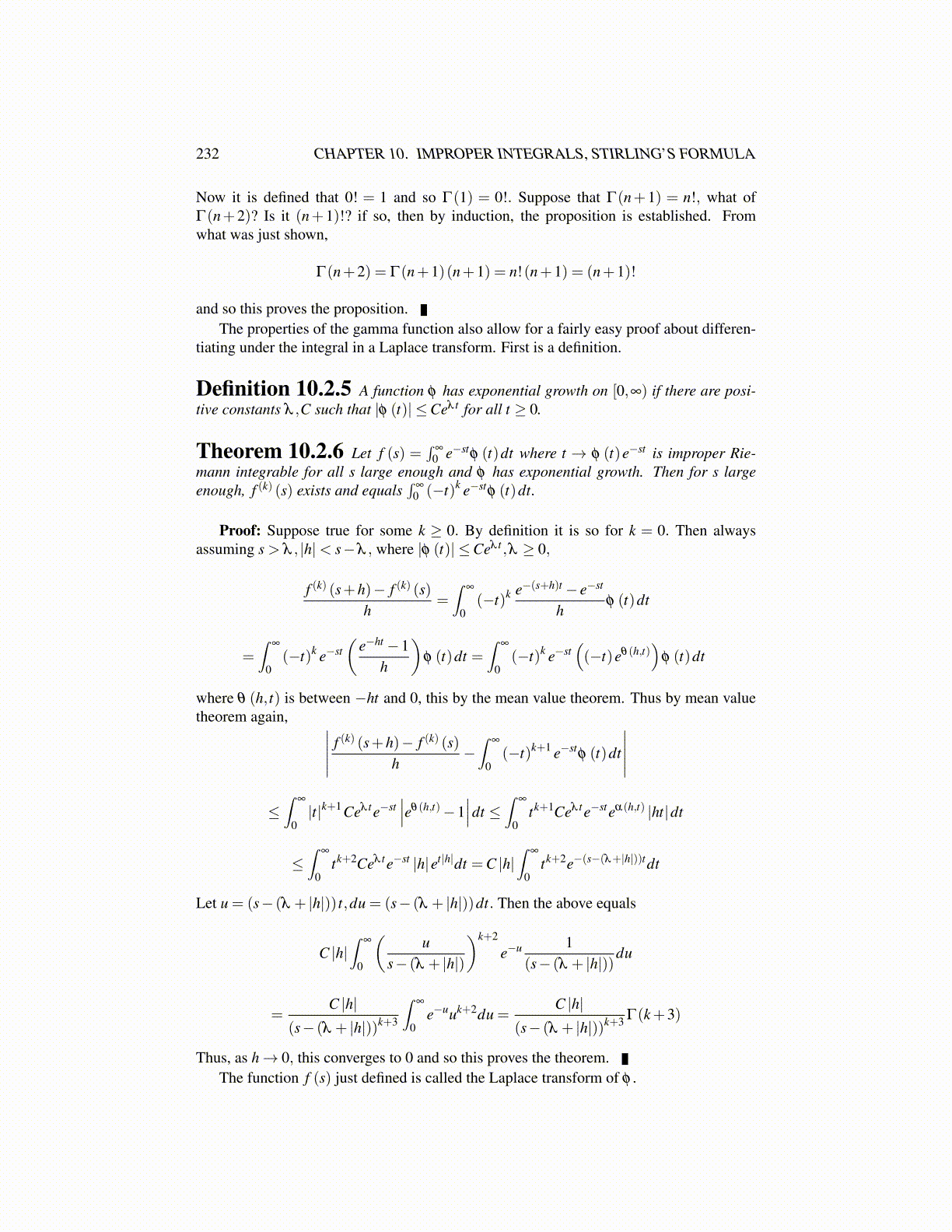
232 CHAPTER 10. IMPROPER INTEGRALS, STIRLING’S FORMULA
Now it is defined that 0! = 1 and so Γ(1) = 0!. Suppose that Γ(n+1) = n!, what ofΓ(n+2)? Is it (n+1)!? if so, then by induction, the proposition is established. Fromwhat was just shown,
Γ(n+2) = Γ(n+1)(n+1) = n!(n+1) = (n+1)!
and so this proves the proposition.The properties of the gamma function also allow for a fairly easy proof about differen-
tiating under the integral in a Laplace transform. First is a definition.
Definition 10.2.5 A function φ has exponential growth on [0,∞) if there are posi-tive constants λ ,C such that |φ (t)| ≤Ceλ t for all t ≥ 0.
Theorem 10.2.6 Let f (s) =∫
∞
0 e−stφ (t)dt where t → φ (t)e−st is improper Rie-mann integrable for all s large enough and φ has exponential growth. Then for s largeenough, f (k) (s) exists and equals
∫∞
0 (−t)k e−stφ (t)dt.
Proof: Suppose true for some k ≥ 0. By definition it is so for k = 0. Then alwaysassuming s > λ , |h|< s−λ , where |φ (t)| ≤Ceλ t ,λ ≥ 0,
f (k) (s+h)− f (k) (s)h
=∫
∞
0(−t)k e−(s+h)t − e−st
hφ (t)dt
=∫
∞
0(−t)k e−st
(e−ht −1
h
)φ (t)dt =
∫∞
0(−t)k e−st
((−t)eθ(h,t)
)φ (t)dt
where θ (h, t) is between −ht and 0, this by the mean value theorem. Thus by mean valuetheorem again, ∣∣∣∣∣ f (k) (s+h)− f (k) (s)
h−∫
∞
0(−t)k+1 e−st
φ (t)dt
∣∣∣∣∣≤∫
∞
0|t|k+1 Ceλ te−st
∣∣∣eθ(h,t)−1∣∣∣dt ≤
∫∞
0tk+1Ceλ te−steα(h,t) |ht|dt
≤∫
∞
0tk+2Ceλ te−st |h|et|h|dt =C |h|
∫∞
0tk+2e−(s−(λ+|h|))tdt
Let u = (s− (λ + |h|)) t,du = (s− (λ + |h|))dt. Then the above equals
C |h|∫
∞
0
(u
s− (λ + |h|)
)k+2
e−u 1(s− (λ + |h|))
du
=C |h|
(s− (λ + |h|))k+3
∫∞
0e−uuk+2du =
C |h|(s− (λ + |h|))k+3 Γ(k+3)
Thus, as h → 0, this converges to 0 and so this proves the theorem.The function f (s) just defined is called the Laplace transform of φ .